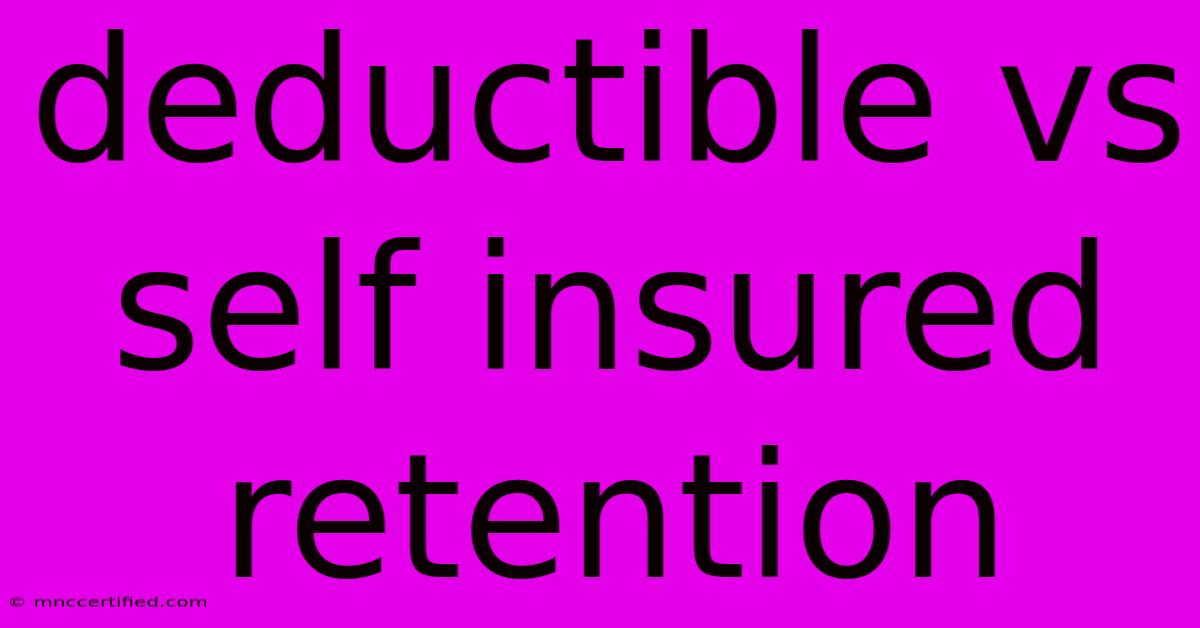Deductible Vs Self Insured Retention

Table of Contents
Deductible vs. Self-Insured Retention: Understanding the Difference
When purchasing insurance, you'll often encounter the terms "deductible" and "self-insured retention" (SIR). While they seem similar, there's a crucial distinction between the two that impacts your financial responsibility in the event of a claim. This article will delve into the differences between deductibles and SIRs, helping you make informed decisions about your insurance coverage.
What is a Deductible?
A deductible is the amount of money you agree to pay out-of-pocket before your insurance coverage kicks in. Think of it as your "share" of the loss. For example, if you have a $500 deductible on your car insurance and you get into an accident causing $2,000 in damages, you'll pay the first $500, and your insurance company will cover the remaining $1,500.
Key Features of a Deductible:
- Applies to most types of insurance: Car, home, health, and even some business policies often have deductibles.
- Fixed amount: The deductible is typically a set amount agreed upon when you purchase your policy.
- Reduces your premium: A higher deductible usually means lower premiums, as you're taking on more financial responsibility.
What is a Self-Insured Retention (SIR)?
A self-insured retention (SIR) is similar to a deductible but is generally found in larger insurance policies, often associated with commercial insurance. It applies specifically to large claims, typically involving significant property damage or liability exposures.
Key Features of an SIR:
- Applies to large claims: SIRs are more common in policies like commercial property, general liability, or umbrella insurance.
- Can be a fixed amount or a percentage: The SIR can be a fixed amount, but it's often expressed as a percentage of the total claim amount.
- Higher impact on your finances: A high SIR means you'll have to pay a considerable sum upfront before your insurance coverage kicks in.
Deductible vs. SIR: The Key Differences
| Feature | Deductible | Self-Insured Retention (SIR) |
|---|---|---|
| Policy Type | Most types of insurance (car, home, health) | Commercial insurance, umbrella insurance |
| Trigger | Any covered claim | Typically large, significant claims |
| Amount | Fixed amount | Fixed amount or percentage of total claim amount |
| Premium Impact | Higher deductible, lower premium | Lower SIR, higher premium |
How to Choose the Right Deductible or SIR
Selecting the right deductible or SIR is a personal decision based on your risk tolerance and financial situation.
Consider these factors:
- Risk Tolerance: How comfortable are you with assuming financial risk?
- Financial Situation: Do you have the financial resources to cover a high deductible or SIR?
- Claim History: Do you have a history of filing claims?
- Premium Costs: Compare premiums for different deductible or SIR options.
Conclusion
Understanding the distinction between deductibles and SIRs is crucial for making informed decisions about your insurance coverage. By carefully considering your needs, risk tolerance, and financial situation, you can choose the deductible or SIR that best suits your specific circumstances.

Thank you for visiting our website wich cover about Deductible Vs Self Insured Retention. We hope the information provided has been useful to you. Feel free to contact us if you have any questions or need further assistance. See you next time and dont miss to bookmark.
Featured Posts
-
1996 Vs Today Cowboys Super Bowl Gap
Nov 11, 2024
-
Man Citys Haaland Bomb Transfer Plan B
Nov 11, 2024
-
Is Enhanced Title Insurance Worth It
Nov 11, 2024
-
Wilsons Big Game Earns Him Respect From Critics
Nov 11, 2024
-
Chelsea Vs Arsenal Premier League Result And Stream
Nov 11, 2024